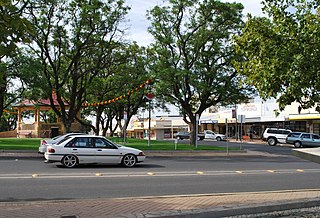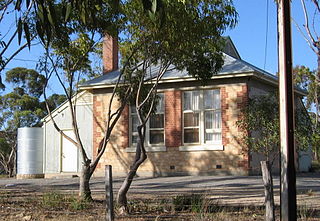
Tailem Bend is a rural town in South Australia, 85 kilometres south-east of the state capital of Adelaide. It is located on the lower reaches of the River Murray, near where the river flows into Lake Alexandrina. It is linear in layout since it is constrained by river cliffs on its western side and the Adelaide–Melbourne railway line is dominant on its eastern side. The town grew and consolidated through being a large railway centre between the 1890s and 1990s; now it continues to service regional rural communities. In the 2021 census, Tailem Bend and the surrounding area had a population of 1,705.
The Division of Barker is an Australian electoral division in the south-east of South Australia. The division was established on 2 October 1903, when South Australia's original single multi-member division was split into seven single-member divisions. It is named for Captain Collet Barker, a British military officer and early explorer, prior to the British Settlement of South Australia, of the southern Mount Lofty Ranges, Fleurieu Peninsula and the region at the mouth of the Murray River near the Coorong where he tragically lost his life in 1831 whilst on active duty after successfully solo swimming the channel of water and went Compass in hand over a sandhill.

Murray Bridge is a city in the Australian state of South Australia, located 78 kilometres (48 mi) east-southeast of the state's capital city, Adelaide, and 77 kilometres (48 mi) north of the town of Meningie.

The Mid Murray Council is a local government area in South Australia in the Murray and Mallee region of South Australia. The council spans the area from the Riverland through the Murraylands to the eastern slopes of the Mount Lofty Ranges. It includes 220 km of the Murray River. The council seat is at Mannum; it also maintains secondary offices at Cambrai and Morgan.
The Murray Mallee is a grain-growing and sheep-farming area in the east of the Australian state of South Australia. The name is not formally designated but is widely used to refer to an area of approximately 20,000 square kilometres bounded by the River Murray on its northern and western sides, the Victorian border on its eastern side, and up to about 50 kilometres south of the Mallee Highway.

The Riverland is a region of South Australia. It covers an area of 9,386 square kilometres (3,624 sq mi) along the River Murray from where it flows into South Australia from New South Wales and Victoria downstream to Blanchetown. The major town centres are Renmark, Berri, Loxton, Waikerie, Barmera and Monash, and many minor townships. The population is approximately 35,000 people.

Loxton is a town on the south bank of the River Murray in the Riverland region of South Australia. It is located on the lands of the Erawirung people who occupied the area before the arrival of Europeans.

Jabuk is a locality in the Australian state of South Australia located about 142 kilometres (88 mi) south-east of the state capital of Adelaide and respectively about 78 kilometres (48 mi) west and 58 kilometres (36 mi) east of the municipal seats of Pinnaroo and Tailem Bend.

Paringa is a small town in the Riverland of South Australia, 17 kilometres from the border with Victoria. It is known for its vineyards and almond, citrus and stone fruit orchards. Its main feature is a six-span bridge that crosses the River Murray. One of the spans can be raised to allow houseboats and paddle-steamers to pass underneath.

The Mallee Football League (MFL) was an Australian rules football competition in South Australia. The league comprised teams located in south eastern South Australia and one team (Murrayville) located in western Victoria.
The River Murray Football League is an Australian rules football competition based in the Murray Bridge region of South Australia, Australia. It is an affiliated member of the South Australian National Football League.
The Border Times, based in Pinnaroo, is the local newspaper of the Southern Mallee region of South Australia since 1911. Published weekly, it focuses on local news, sports and weather.

Yumali is a town in South Australia 162 km southeast of Adelaide on the Dukes Highway (A8). Yumali belongs to The Coorong District Council and is in the State electorate of Hammond and the Federal electorate of Barker. Yumali is in the County of Buccleuch.

Coorong District Council is a local government area in South Australia located between the River Murray and the Limestone Coast region. The district covers mostly rural areas with small townships, as well as part of the Coorong National Park.

The Loxton railway line is a closed railway line in the northern Murray Mallee region of South Australia. It ran north-east from Tailem Bend to grain silos near Loxton.
The Barmera railway line was the second railway built to develop the Murray Mallee region of South Australia, in 1913. It followed the success of the Pinnaroo railway line in 1906. Both lines branched east from Tailem Bend to the north of the main Melbourne–Adelaide railway. The Brown's Well line was the more northerly, and extended into country which had not been developed much before the railway, partly due to the absence of any viable transport route for produce. The original terminus of the Brown's Well railway was at Meribah, not far from the Victorian border.
In South Australia, one of the states of Australia, there are many areas which are commonly known by regional names. Regions are areas that share similar characteristics. These characteristics may be natural such as the Murray River, the coastline, desert or mountains. Alternatively, the characteristics may be cultural, such as common land use. South Australia is divided by numerous sets of regional boundaries, based on different characteristics. In many cases boundaries defined by different agencies are coterminous.
Bowhill is a locality in South Australia. A settlement is located inside a bend on the left (eastern/southern) bank of the Murray River between Mannum and Swan Reach. It is predominantly shacks built facing the river bank. The settlement is in the Mid Murray Council area, but most of the locality is located away from the river and within the District Council of Karoonda East Murray, including the Lowan Conservation Park.
Elwomple is a locality in The Coorong District Council in the South Australian Murray Mallee, southeast of Tailem Bend. The northwest corner is the junction of the Mallee Highway which forms the northern boundary of Elwomple, and the Dukes Highway which forms the southwestern boundary. The Bend Motorsport Park was developed in Elwomple adjacent to this junction. In September 2017, before the facility opened, the boundary between Tailem Bend and Elwomple was adjusted so that The Bend Motorsport Park was officially in Tailem Bend, not Elwomple.












